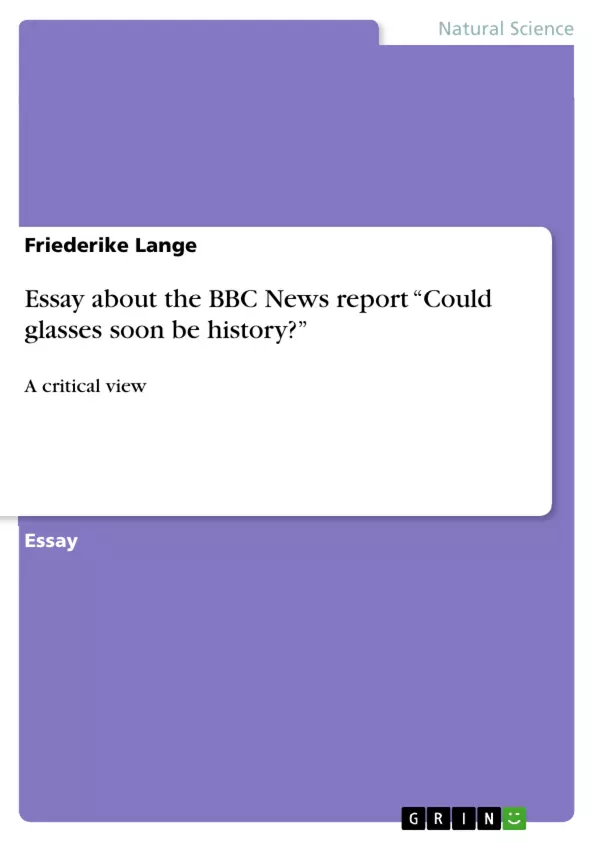On the 14th of September 2010 a report was published in the BBC News Magazine by Tom Geoghegan1, in which the content guarantees to change the standard of living of many people. With the eye catching headline “Could glasses soon be history?” it attracts the attention of many readers, especially of those who wear spectacles. It tells about new research by scientists, who discovered a gene which has the potential to cause short-sightedness, however the report describes the scientific background regarding this discovery in a more superficial manner. It holds its main focus of attention on the way in which glasses are integrated in our society nowadays. It mentions briefly why in times gone by it was very unlikely for people to wear glasses, how people were teased by needing glasses. Nowadays they are more accepted and have become a kind of accessory. So even if someone does not need to wear glasses, they do it anyway. In taking this focus the articles attention is off the point, it overshadows the science behind the topic “short - sightedness and its genetic cause”.
Inhaltsverzeichnis (Table of Contents)
- Introduction
- Short-Sightedness (Myopia)
- Prevalence of Myopia
- Causes of Myopia
- Genetic Aspects of Myopia
- The Research of Hysi et al.
- The Research of Solouki et al.
- Discussion and Conclusion
Zielsetzung und Themenschwerpunkte (Objectives and Key Themes)
This essay aims to analyze a BBC News Magazine report on the discovery of a gene potentially linked to short-sightedness. It critically evaluates the report's presentation of the research findings and delves into the complex scientific background surrounding the genetic basis of myopia.
- The prevalence and impact of myopia.
- The complex causes of myopia, including both genetic and environmental factors.
- The role of genetic research in understanding and potentially treating myopia.
- A critical examination of the BBC News report's simplification and potential exaggeration of scientific findings.
- The ongoing research and future directions in the field of myopia treatment.
Zusammenfassung der Kapitel (Chapter Summaries)
- Introduction: This section introduces the BBC News report and its main claim: the discovery of a gene potentially causing short-sightedness. It highlights the report's focus on the societal implications of myopia, while acknowledging the superficial treatment of the scientific context.
- Short-Sightedness (Myopia): This chapter provides a basic definition and explanation of myopia, its visual effects, and the structural changes within the eye that contribute to the condition.
- Prevalence of Myopia: This section discusses the global prevalence of myopia, highlighting the rising number of individuals affected, particularly in East Asia. It also discusses the challenges in accurately determining the true extent of myopia due to limited access to eye care in certain regions.
- Causes of Myopia: This chapter explores the complex interplay of genetic and environmental factors contributing to the development of myopia. It discusses various risk factors such as family history, education, screen time, and outdoor exposure.
- Genetic Aspects of Myopia: This section delves into the growing body of research suggesting a significant genetic component to myopia, with heritability estimates as high as 80%. The BBC News report's simplification of the genetic basis of myopia is discussed, emphasizing the likely involvement of multiple genes and genetic variations.
- The Research of Hysi et al.: This chapter presents a detailed analysis of a specific genome-wide association study (GWAS) conducted by Hysi et al. The study identified a region on chromosome 15q25, including the RASGRF1 gene, as potentially linked to refractive errors, including myopia.
- The Research of Solouki et al.: This chapter focuses on a separate GWAS study by Solouki et al. which identified a different region on chromosome 15q14, encompassing the ACTC1 and GJD2 genes, as potentially associated with myopia.
Schlüsselwörter (Keywords)
Myopia, short-sightedness, refractive errors, genetics, genome-wide association study (GWAS), RASGRF1, ACTC1, GJD2, Connexin36, SNPs, linkage disequilibrium, eye development, visual processing, synaptic transmission, photoreceptor responses, eye growth, prevention, therapy.
- Arbeit zitieren
- Friederike Lange (Autor:in), 2010, Essay about the BBC News report “Could glasses soon be history?”, München, GRIN Verlag, https://www.hausarbeiten.de/document/179166


